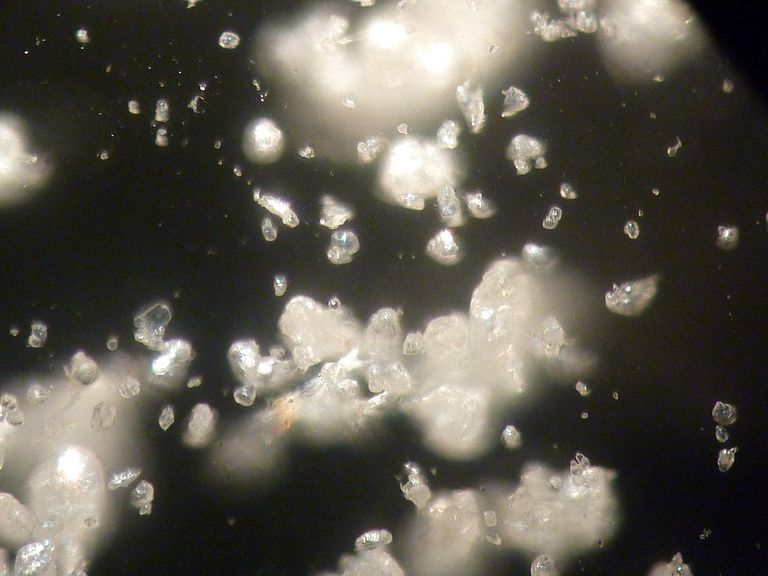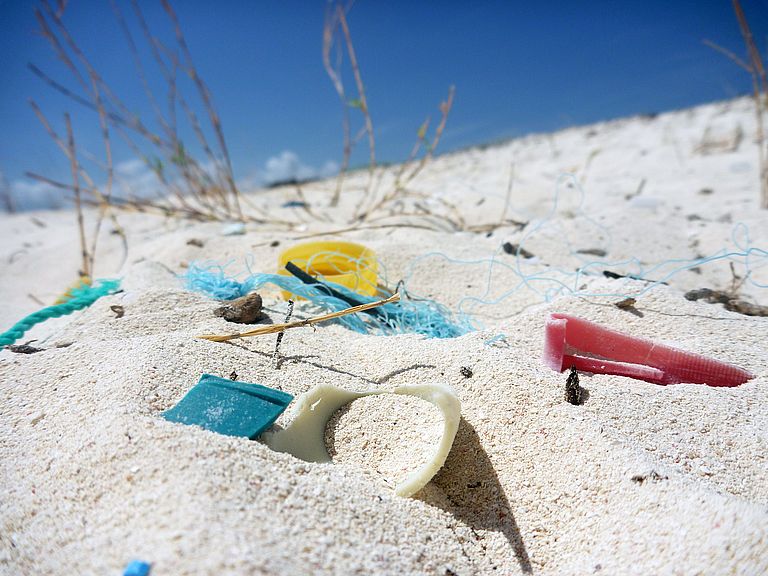Micro- and nanoplastics from the atmosphere pollute oceans
An international research team investigates the atmosphere as a relevant source of plastic pollution in water bodies in a recent study
- Joint press release of the Alfred Wegener Institute, Helmholtz Centre for Polar and Marine Research, GEOMAR Helmholtz Centre for Ocean Research Kiel and the Institute for Transformative Sustainability Research Potsdam -
Between 0.013 and 25 million tons of micro- and nanoplastics are currently transported up to thousands of kilometers across countries, continents and oceans each year by ocean air, snow, sea spray or fog. That's the estimate of an international team of 33 researchers, including from the Alfred Wegener Institute, Helmholtz Centre for Polar and Marine Research (AWI), the Institute for Transformative Sustainability Research Potsdam (IASS) and GEOMAR Helmholtz Centre for Ocean Research Kiel.
"Air is a much more dynamic medium than water," says co-author Dr. Melanie Bergmann of AWI. "Micro- and nanoplastics can thus penetrate much more quickly into the few as yet almost untouched and most remote areas of our planet." Here, the particles could affect the surface climate and the health of ecosystems. If darker particles are deposited in snow and ice, for example, they affect the ice-albedo feedback, meaning they could reduce their ability to reflect solar energy, causing snow and ice to melt. Darker ocean surfaces, in turn, absorb more solar energy, further heating the oceans. In addition, microplastic particles in the atmosphere can act as condensation nuclei for water vapor, affecting cloud formation and, in the long term, the climate.
How do plastic particles get into the atmosphere?
On the one hand, through human activities. Particles from tire and brake wear, from road traffic or from exhaust gases from industrial processes enter the atmosphere and are carried there. However, according to the overview study, there are indications that, on the other hand, a considerable amount is also transported via the marine environment. Initial investigations suggest that microplastics from the coastal zone enter the sea via eroded beach sand. Sea spray, wind and waves create air bubbles in the water that contain microplastics. This enters the atmosphere when the bubbles burst. Long-distance transport to remote and polar regions could therefore be a combination of atmospheric and marine transport.
Therefore, it is important to understand the interactions between the atmosphere and the ocean to determine which particle sizes are transferred and in what quantities. The atmosphere predominantly carries small microplastic particles, making it a much faster transport pathway that can lead to significant deposition in different ecosystems. Melanie Bergmann explains, "We need to integrate microplastics and nanoplastics into our air pollution measurements, and ideally do so internationally as part of global networks." As a first step, study lead author Deonie Allen and Melanie Bergmann began sampling microplastics in the air, seawater and ice for this purpose during a polar expedition to the Arctic last year.
Understanding the microplastic cycle
Collaborative efforts are needed to better understand and characterize the microplastic cycle between the ocean and the atmosphere. To that end, the research team, led by lead authors Deonie Allen and Steve Allen of the University of Strathclyde, Glasgow, outlines a global strategy in the study to build a cohesive, comparable dataset showing the flow of micro- and nanoplastics between the ocean and atmosphere. "There are so many aspects we still don't know about the emissions, transport and effects of microplastics in the atmosphere," says co-author Professor Tim Butler, Ph.D., of the IASS. "This publication lays out the gaps in our knowledge - and charts a path forward."
Two specifically focused working groups of the Joint Group of Experts on the Scientific Aspects of Marine Environmental Protection (GESAMP) produced the study. Co-author of the study and member of GESAMP, Professor Dr. Sylvia Sander from GEOMAR says: "The study makes clear that overarching insights into the ocean, and the effects of human influences on it, are only possible at all through the networking of researchers and their data. The greatest challenges of our time are on a global scale. We must therefore get to the bottom of pressing current issues with the broadest possible international expertise. This can only be done together." GESAMP is an alliance of eleven United Nations organizations with the goal of achieving a multidisciplinary scientific understanding of the marine environment. To this end, the network has already collaborated with more than 500 scientists from various countries on a range of issues.
Micro- and nanoplastics in the air are also important for human health. In a recent British study, microplastics were detected in eleven out of 13 lungs of living people. "This is another reason why we should include plastics in air quality monitoring programs," Melanie Bergmann emphasizes. In order to reduce the amount of plastic entering the environment, Bergmann and other experts recently wrote a letter to the journal Science calling for the production of new plastic to be gradually reduced as part of an international agreement.
Original publication
Deonie Allen et al.: Micro- and nanoplastics in the marine-atmospheric environment. Nature Reviews Earth & Environment (2022). DOI: 10.1038/s43017-022-00292-x




